【VIP专享】计算机辅助翻译工具 Across 概述-王华树
- 格式:pdf
- 大小:1.55 MB
- 文档页数:11
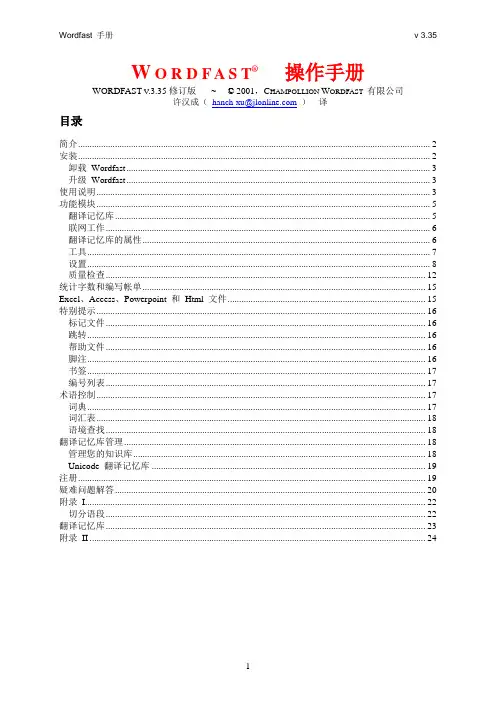
Wordfast 手册v 3.35 W O R D F A S T®操作手册WORDFAST V.3.35修订版~©2001,C HAMPOLLION W ORDFAST 有限公司许汉成(hanch-xu@)译目录简介 (2)安装 (2)卸载Wordfast (3)升级Wordfast (3)使用说明 (3)功能模块 (5)翻译记忆库 (5)联网工作 (6)翻译记忆库的属性 (6)工具 (7)设置 (8)质量检查 (12)统计字数和编写帐单 (14)Excel、Access、Powerpoint 和Html 文件 (15)特别提示 (15)标记文件 (15)跳转 (16)帮助文件 (16)脚注 (16)书签 (16)编号列表 (16)术语控制 (17)词典 (17)词汇表 (17)语境查找 (17)翻译记忆库管理 (18)管理您的知识库 (18)Unicode 翻译记忆库 (18)注册 (19)疑难问题解答 (19)附录I (22)切分语段 (22)翻译记忆库 (23)附录II (23)1简介Wordfast是一种计算机辅助翻译软件(CAT),它溶合了两种技术:语段切分和翻译记忆库。
熟悉这些概念的读者应该阅读附录I,那里有简单的介绍。
Wordfast 包含了一个实时质量检查(QC)工具(其中有一个排版检查器)和一个高级质量控制词汇表功能。
这一可以由用户定制的特性跟踪检查译者的排版/术语准确性,实在是CAT工业上的一个突破。
换句话说,用户的重要术语可以很容易地加入Wordfast,并且所有语段的术语一致性都可以在翻译进程中进行检查。
此外,大量文档的质量检查可以以批处理的方式进行,项目经理可以得到一个关于所处理文档的排版/术语质量详尽的报告。
Wordfast在MS-Word里工作,但也可以翻译Ms-Office™ 文档(如Ms-Excel™、Ms-Access™、Ms-PowerPoint™)和HTML 文档。

理工科院校翻译专业硕士教学中计算机辅助翻译课程的设计研究论文关键词:计算机辅助翻译理工科院校MTI培养论文摘要:本文以燕山大学翻译专业硕士课程设计中的计算机辅助翻译课程为例,着重探讨如何充分利用现有教学和科研资源的可行性,提出以技术资源为保障的实训平台建设、以工程技术为特色的翻译专业语料库和术语库的建立、以项目为依托的翻译实践平台建设和以就业为导向的对口翻译实践培养模式,以适应理工类院校翻译专业硕士培养和发展的需要。
一、引言计算机辅助翻译(CA T)是指利用计算机程序设计将一种自然语言翻译成另一种自然语言的过程。
与将文中的词语用软件作简单过程处理的机器翻译不同,计算机辅助翻译能够利用数据库功能和翻译记忆程序,为翻译人员提供建议和解决方案,这样便能够有效节约翻译时间及成本,同时确保翻译品质和风格的一致性。
CA T技术的核心是翻译记忆技术,也就是当译者在前台进行翻译工作时,CA T的后台同时自动进行语言数据库的建立和更新。
CA T在国内作为一门硕士研究生课程最初是按照学术型硕士培养方案要求,设立在翻译方向课程体系下的一门选修课程。
无论是在教学大纲的设计,还是授课方式上,该课程均以课堂理论讲授和掌握翻译软件原理为主,真正与实践结合的翻译活动不多,考核方式也均以给定的翻译语篇为主,学生毕业后仍然无法真正领会和展现应有的翻译技能和方法,甚至造成了对计算机辅助翻译的一些误解和偏见。
自从2007年3月国务院学位委员会发布翻译硕士专业学位设置方案以来,翻译专业硕士在多所高校蓬勃发展。
作为培养专业翻译人才的一种全新模式,CAT也成为MTI培养体系中的一个重要环节。
俞敬松、王华树(2010)以北京大学为例,探讨了计算机辅助翻译硕士专业教学中课程设计定位和教学计划的设定,教学过程中所面临的各种问题和解决思路。
王立非、王进铨(2008)着重介绍了panaconc软件在翻译语料库研究中的应用以及计算机辅助方法对翻译研究的意义。
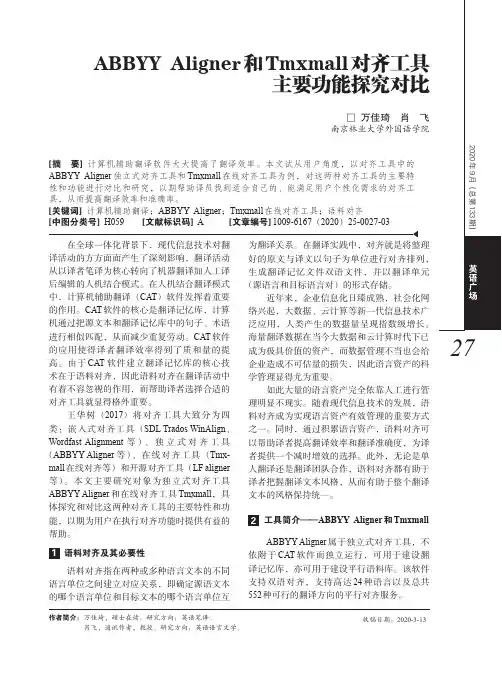
在全球一体化背景下,现代信息技术对翻译活动的方方面面产生了深刻影响,翻译活动从以译者笔译为核心转向了机器翻译加人工译后编辑的人机结合模式。
在人机结合翻译模式中,计算机辅助翻译(CAT)软件发挥着重要的作用。
CAT软件的核心是翻译记忆库,计算机通过把源文本和翻译记忆库中的句子、术语进行相似匹配,从而减少重复劳动。
CAT软件的应用使得译者翻译效率得到了质和量的提高。
由于CAT软件建立翻译记忆库的核心技术在于语料对齐,因此语料对齐在翻译活动中有着不容忽视的作用,而帮助译者选择合适的对齐工具就显得格外重要。
王华树(2017)将对齐工具大致分为四类:嵌入式对齐工具(SDL Trados WinAlign、Wordfast Alignment等)、独立式对齐工具(ABBYY Aligner等)、在线对齐工具(Tmx-mall在线对齐等)和开源对齐工具(LF aligner 等)。
本文主要研究对象为独立式对齐工具ABBYY Aligner和在线对齐工具Tmxmall,具体探究和对比这两种对齐工具的主要特性和功能,以期为用户在执行对齐功能时提供有益的帮助。
1语料对齐及其必要性语料对齐指在两种或多种语言文本的不同语言单位之间建立对应关系,即确定源语文本的哪个语言单位和目标文本的哪个语言单位互为翻译关系。
在翻译实践中,对齐就是将整理好的原文与译文以句子为单位进行对齐排列,生成翻译记忆文件双语文件,并以翻译单元(源语言和目标语言对)的形式存储。
近年来,企业信息化日臻成熟,社会化网络兴起,大数据、云计算等新一代信息技术广泛应用,人类产生的数据量呈现指数级增长。
海量翻译数据在当今大数据和云计算时代下已成为极具价值的资产,而数据管理不当也会给企业造成不可估量的损失,因此语言资产的科学管理显得尤为重要。
如此大量的语言资产完全依靠人工进行管理明显不现实。
随着现代信息技术的发展,语料对齐成为实现语言资产有效管理的重要方式之一。
同时,通过积累语言资产,语料对齐可以帮助译者提高翻译效率和翻译准确度,为译者提供一个减时增效的选择。
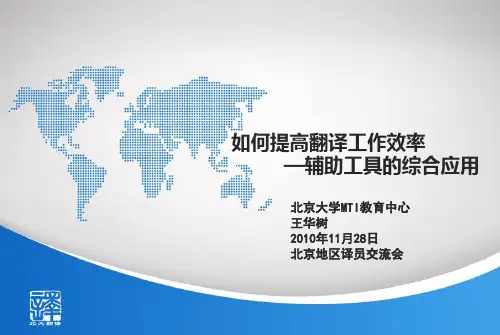
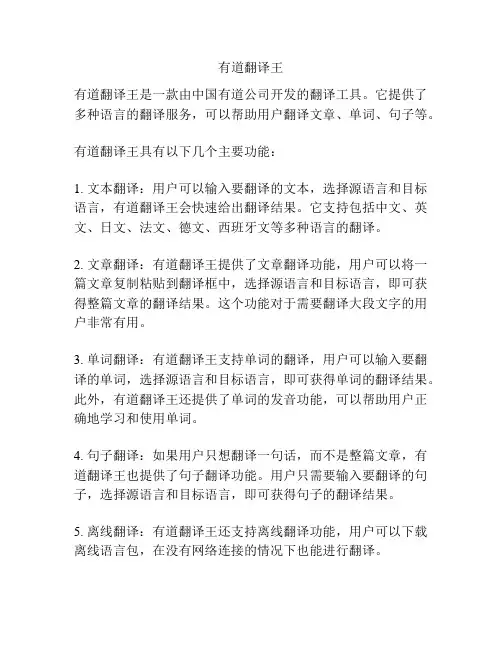
有道翻译王
有道翻译王是一款由中国有道公司开发的翻译工具。
它提供了多种语言的翻译服务,可以帮助用户翻译文章、单词、句子等。
有道翻译王具有以下几个主要功能:
1. 文本翻译:用户可以输入要翻译的文本,选择源语言和目标语言,有道翻译王会快速给出翻译结果。
它支持包括中文、英文、日文、法文、德文、西班牙文等多种语言的翻译。
2. 文章翻译:有道翻译王提供了文章翻译功能,用户可以将一篇文章复制粘贴到翻译框中,选择源语言和目标语言,即可获得整篇文章的翻译结果。
这个功能对于需要翻译大段文字的用户非常有用。
3. 单词翻译:有道翻译王支持单词的翻译,用户可以输入要翻译的单词,选择源语言和目标语言,即可获得单词的翻译结果。
此外,有道翻译王还提供了单词的发音功能,可以帮助用户正确地学习和使用单词。
4. 句子翻译:如果用户只想翻译一句话,而不是整篇文章,有道翻译王也提供了句子翻译功能。
用户只需要输入要翻译的句子,选择源语言和目标语言,即可获得句子的翻译结果。
5. 离线翻译:有道翻译王还支持离线翻译功能,用户可以下载离线语言包,在没有网络连接的情况下也能进行翻译。
总的来说,有道翻译王是一款功能丰富的翻译工具,它简单易用,翻译准确,帮助用户解决了语言沟通的难题。
无论是在学习外语、旅游、工作还是其他方面,有道翻译王都是一个非常实用的工具。
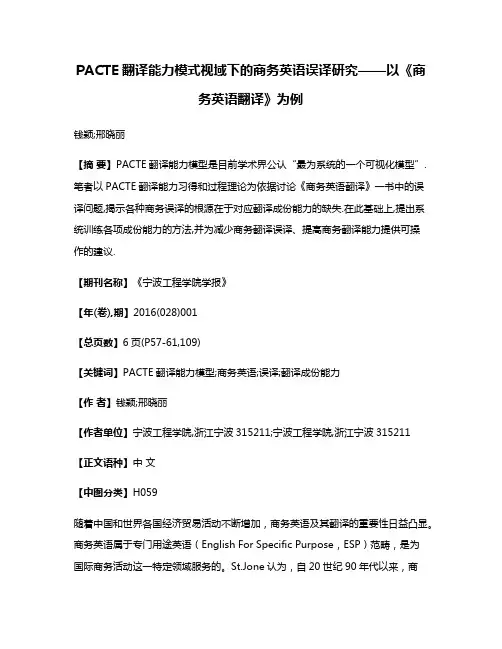
PACTE翻译能力模式视域下的商务英语误译研究——以《商务英语翻译》为例钱颖;邢晓丽【摘要】PACTE翻译能力模型是目前学术界公认“最为系统的一个可视化模型”.笔者以PACTE翻译能力习得和过程理论为依据讨论《商务英语翻译》一书中的误译问题,揭示各种商务误译的根源在于对应翻译成份能力的缺失.在此基础上,提出系统训练各项成份能力的方法,并为减少商务翻译误译、提高商务翻译能力提供可操作的建议.【期刊名称】《宁波工程学院学报》【年(卷),期】2016(028)001【总页数】6页(P57-61,109)【关键词】PACTE翻译能力模型;商务英语;误译;翻译成份能力【作者】钱颖;邢晓丽【作者单位】宁波工程学院,浙江宁波315211;宁波工程学院,浙江宁波315211【正文语种】中文【中图分类】H059随着中国和世界各国经济贸易活动不断增加,商务英语及其翻译的重要性日益凸显。
商务英语属于专门用途英语(English For Specific Purpose,ESP)范畴,是为国际商务活动这一特定领域服务的。
St.Jone认为,自20世纪90年代以来,商务英语已经发展成为专门用途英语最重要的一个分支(St. Jone,1995)。
据统计,在全球超10亿的英语用户中,90%以上的人已将英语应用在商务活动中。
商务英语的蓬勃发展引发翻译需求。
与普通翻译应用相比,商务英语通常与金融、投资、保险、合同等严肃的经济活动密切相关,因此商务翻译对“准确”、“严谨”的标准更高,译文要求遣词造句准确、概念表达明确、物名所指正确、数码单位精确。
涉及专业内容的商务英语翻译对误解和误译是零容忍的。
那么商务英语翻译的现状如何?查阅文献发现,现实情况不容乐观。
商务英语翻译中的误译现象绝非个例,甚至连冠以普通高等教育“十一五”国家级规划教材的《商务英语翻译》,在其第二次再版中依然难以杜绝误译。
商务英语的专业性决定其翻译并不是一项能让不同译者各自发挥、“见仁见智”的活动。
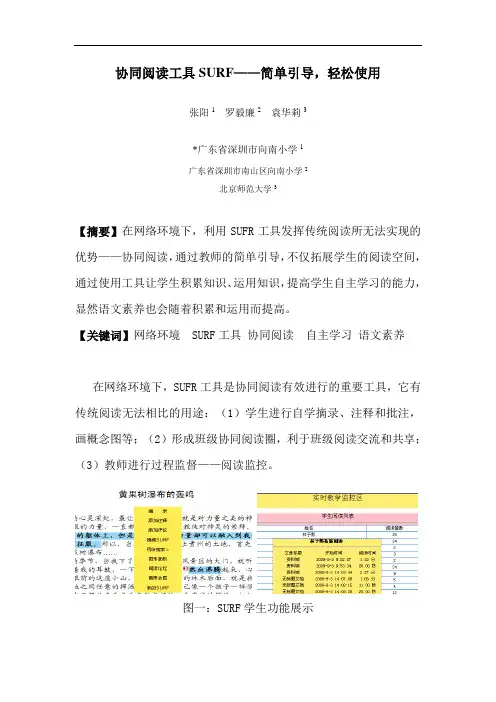
协同阅读工具SURF——简单引导,轻松使用张阳1 罗毅廉2 袁华莉3*广东省深圳市向南小学1广东省深圳市南山区向南小学2北京师范大学3【摘要】在网络环境下,利用SUFR工具发挥传统阅读所无法实现的优势——协同阅读,通过教师的简单引导,不仅拓展学生的阅读空间,通过使用工具让学生积累知识、运用知识,提高学生自主学习的能力,显然语文素养也会随着积累和运用而提高。
【关键词】网络环境 SURF工具协同阅读自主学习语文素养在网络环境下,SUFR工具是协同阅读有效进行的重要工具,它有传统阅读无法相比的用途:(1)学生进行自学摘录、注释和批注,画概念图等;(2)形成班级协同阅读圈,利于班级阅读交流和共享;(3)教师进行过程监督——阅读监控。
图一:SURF学生功能展示一、牛刀小试,成果与问题并存在SURF工具的支持下,学生的阅读兴趣得到很大提高,而且在使用的过程中学会了提出问题、分析问题和解决问题,学生之间的讨论也从课内延伸到课外。
但随着SURF工具应用的深入和频繁,一些问题也开始暴露出来:1.阅读工具使用凌乱。
SURF作为学习辅助工具,其功能很齐全,但是也有重复,比如“评论”和“图形面板”的“我的评论”、“图形面板”上的“帮助”和“我的疑问”也有异曲同工之调,因此,学生运用起来就会这个工具使用一段时间,那个工具使用一段时间,或者在使用的过程中迷失于工具的选择中。
学生的年龄特征就是注意力很容易分散,不能长时间注意。
过多地选择工具而忽略了工具本身的意义,这样不但没有在有限的时间里提高阅读的质量,反而会被工具所吸引,这种情况在一开始使用的时候特别突出。
图二:评论凌乱2.评论和批注内容空洞。
阅读如果单纯为阅读而阅读,没有积累,那只能是走马观花,一无所获。
SURF工具既能让学生投入到阅读中去,集中学生的注意力,又对于学生的积累有着不可或缺的功用。
但是,在阅读的过程中,学生使用的时候总是随意摘抄,简单评论,阅读只在表层面上的理解,并没有读深读懂,工具的使用只是作为一个装饰而没有用到实处。
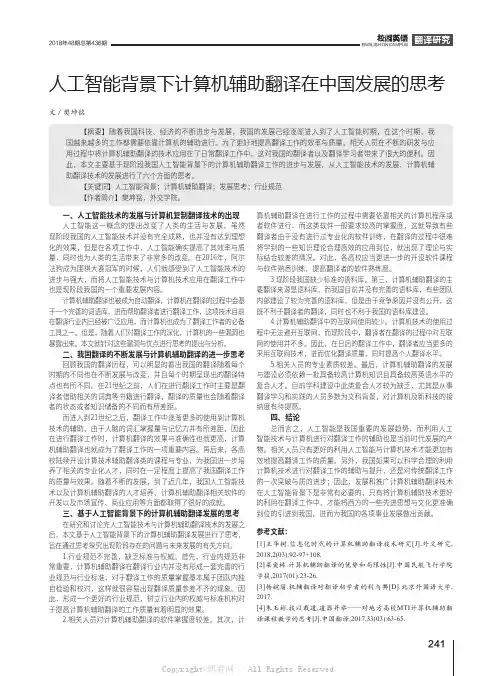
2412018年48期总第436期ENGLISH ON CAMPUS人工智能背景下计算机辅助翻译在中国发展的思考文/樊坤铭【摘要】随着我国科技、经济的不断进步与发展,我国的发展已经逐渐进入到了人工智能时期,在这个时期,我国越来越多的工作都需要依靠计算机的辅助进行。
为了更好地提高翻译工作的效率与质量,相关人员在不断的研发与应用过程中将计算机辅助翻译的技术应用在了日常翻译工作中,这对我国的翻译者以及翻译学习者带来了很大的便利。
因此,本文主要基于现阶段我国人工智能背景下的计算机辅助翻译工作的进步与发展,从人工智能技术的发展、计算机辅助翻译技术的发展进行了六个方面的思考。
【关键词】人工智能背景;计算机辅助翻译;发展思考;行业规范【作者简介】樊坤铭,外交学院。
一、人工智能技术的发展与计算机复制翻译技术的出现人工智能这一概念的提出改变了人类的生活与发展,虽然现阶段我国的人工智能技术并没有完全成熟,也并没有达到理想化的效果,但是在各项工作中,人工智能确实提高了其效率与质量,同时也为人类的生活带来了非常多的改变。
在2016年,阿尔法狗成为围棋大赛冠军的时候,人们就感受到了人工智能技术的进步与强大,而将人工智能技术与计算机技术应用在翻译工作中也是现阶段我国的一个重要发展内容。
计算机辅助翻译也被成为自动翻译,计算机在翻译的过程中会基于一个完善的词语库,进而帮助翻译者进行翻译工作,这项技术目前在翻译行业内已经被广泛应用,而计算机也成为了翻译工作者的必备工具之一。
但是,随着人们对翻译工作的深化,计算机的一些漏洞也暴露出来。
本文就针对这些漏洞与优点进行思考的提出与分析。
二、我国翻译的不断发展与计算机辅助翻译的进一步思考回顾我国的翻译历程,可以明显的看出我国的翻译随着每个时期的不同也在不断发展与改变,并且每个时期呈现出的翻译特点也有所不同。
在21世纪之前,人们在进行翻译工作时主要是翻译者借助相关的词典等书籍进行翻译,翻译的质量也会随着翻译者的状态或者知识储备的不同而有所差距。
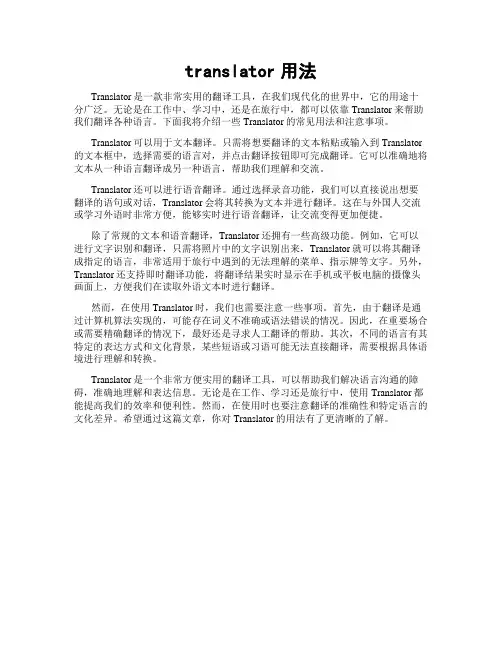
translator用法Translator是一款非常实用的翻译工具,在我们现代化的世界中,它的用途十分广泛。
无论是在工作中、学习中,还是在旅行中,都可以依靠Translator来帮助我们翻译各种语言。
下面我将介绍一些Translator的常见用法和注意事项。
Translator可以用于文本翻译。
只需将想要翻译的文本粘贴或输入到Translator 的文本框中,选择需要的语言对,并点击翻译按钮即可完成翻译。
它可以准确地将文本从一种语言翻译成另一种语言,帮助我们理解和交流。
Translator还可以进行语音翻译。
通过选择录音功能,我们可以直接说出想要翻译的语句或对话,Translator会将其转换为文本并进行翻译。
这在与外国人交流或学习外语时非常方便,能够实时进行语音翻译,让交流变得更加便捷。
除了常规的文本和语音翻译,Translator还拥有一些高级功能。
例如,它可以进行文字识别和翻译,只需将照片中的文字识别出来,Translator就可以将其翻译成指定的语言,非常适用于旅行中遇到的无法理解的菜单、指示牌等文字。
另外,Translator还支持即时翻译功能,将翻译结果实时显示在手机或平板电脑的摄像头画面上,方便我们在读取外语文本时进行翻译。
然而,在使用Translator时,我们也需要注意一些事项。
首先,由于翻译是通过计算机算法实现的,可能存在词义不准确或语法错误的情况。
因此,在重要场合或需要精确翻译的情况下,最好还是寻求人工翻译的帮助。
其次,不同的语言有其特定的表达方式和文化背景,某些短语或习语可能无法直接翻译,需要根据具体语境进行理解和转换。
Translator是一个非常方便实用的翻译工具,可以帮助我们解决语言沟通的障碍,准确地理解和表达信息。
无论是在工作、学习还是旅行中,使用Translator都能提高我们的效率和便利性。
然而,在使用时也要注意翻译的准确性和特定语言的文化差异。
希望通过这篇文章,你对Translator的用法有了更清晰的了解。
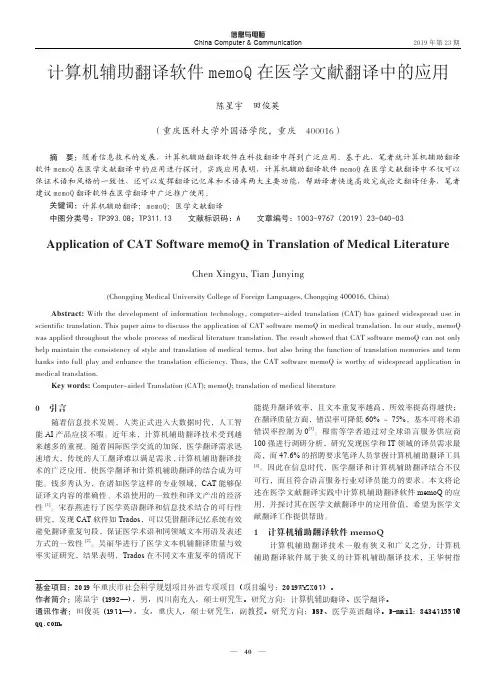
2019年第23期信息与电脑China Computer & Communication软件开发与应用计算机辅助翻译软件memoQ 在医学文献翻译中的应用陈星宇 田俊英(重庆医科大学外国语学院,重庆 400016)摘 要:随着信息技术的发展,计算机辅助翻译软件在科技翻译中得到广泛应用。
基于此,笔者就计算机辅助翻译软件memoQ 在医学文献翻译中的应用进行探讨。
实践应用表明,计算机辅助翻译软件memoQ 在医学文献翻译中不仅可以保证术语和风格的一致性,还可以发挥翻译记忆库和术语库两大主要功能,帮助译者快速高效完成论文翻译任务,笔者建议memoQ 翻译软件在医学翻译中广泛推广使用。
关键词:计算机辅助翻译;memoQ;医学文献翻译中图分类号:TP393.08;TP311.13 文献标识码:A 文章编号:1003-9767(2019)23-040-03Application of CAT Software memoQ in Translation of Medical LiteratureChen Xingyu, Tian Junying(Chongqing Medical University College of Foreign Languages, Chongqing 400016, China)Abstract: With the development of information technology, computer-aided translation (CAT) has gained widespread use inscientific translation. This paper aims to discuss the application of CAT software memoQ in medical translation. In our study, memoQ was applied throughout the whole process of medical literature translation. The result showed that CAT software memoQ can not only help maintain the consistency of style and translation of medical terms, but also bring the function of translation memories and termbanks into full play and enhance the translation efficiency. Thus, the CAT software memoQ is worthy of widespread application in medical translation.Key words: Computer-aided Translation (CAT); memoQ; translation of medical literature0 引言随着信息技术发展,人类正式进入大数据时代,人工智能AI 产品应接不暇。
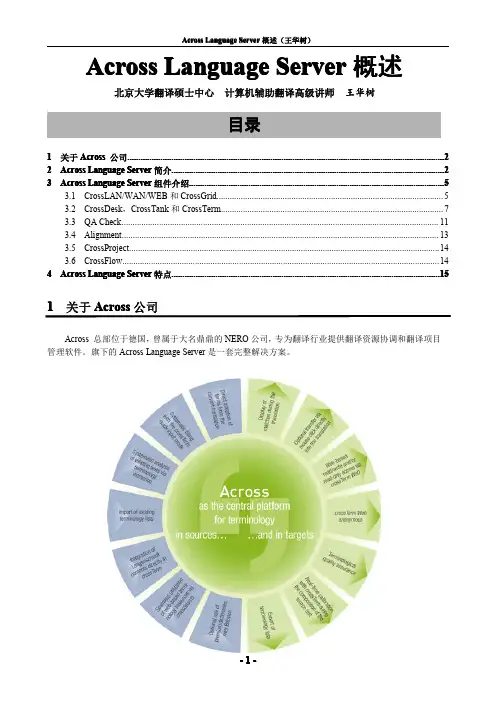
Across Language Server概述北京大学翻译硕士中心计算机辅助翻译高级讲师王华树目录 (22)1关于Across公司................................................................................................................................................ (22)2Across Language Server简介............................................................................................................................ 3Across Language Server组件介绍.................................................................................................................... (55)3.1CrossLAN/WAN/WEB和CrossGrid (5)3.2CrossDesk,CrossTank和CrossTerm (7)3.3QA Check (11)3.4Alignment (13)3.5CrossProject (14)3.6CrossFlow (14)4Across Language Server特点.......................................................................................................................... (1515)1关于Across公司Across总部位于德国,曾属于大名鼎鼎的NERO公司,专为翻译行业提供翻译资源协调和翻译项目管理软件。
A Study on the Cultivation of CAT Ability ofTranslation Majors in Big Data EraWang JingDepartment of translation, College of foreign languages Zhejiang International Studies UniversityHangzhou, ChinaZhu XiaodongInformation InstituteNingbo City College of Vocation TechnologyNingbo, China*****************Abstract—This paper discusses how to improve the ability of college students majoring in translation to use CAT software. With the arrival of big data's time, the mode of translation has also changed greatly. For example, the new mode based on "Internet big data Translation", represented by crowdsourcing translation, has become an embryonic form. Every translator can cooperate with all kinds of translators around the world through the translation platform. In order to adapt to this kind of work mode, the translator must have the ability to make use of all kinds of information technology and tools. The most important of these tools is the CAT (computer aided Translation) software. Only when students are able to skillfully use a variety of tools, including using a cloud translation (machine translation) platform, can they adapt to the requirements of the current language service market for translators who will be more competitive in the future job market.Keywords—Internet +; Big data; Crowdsourcing translation; Computer aided translation; Machine translationI.I NTRODUCTIONWith the popularization of the technology of mobile Internet, large data and cloud computing, the revolution of information technology is bringing great impact and influence to the traditional industries. The model of translation work based on "Internet, big data and translation", represented by "Crowdsourcing Translation ", has become a prototype. The translation work is no longer the use of limited personal resources for creation, but the use of large amounts of large data on the Internet to cooperate with various translators all over the world through the translation platform. If anyone can make good use of information technology and "Internet + big data + translation” platform, he will have a better development prospect and opportunity. The traditional mode of translation mainly originates from the enterprise and the publishing industry, the current "Internet +" model has begun to break the traditional boundaries of the translation industry, with the development of globalization, various aspects of the demand for translation has been a great release.The research group (PACTE) of the American "translation competence acquisition and evaluation" has proposed the structure model of translation ability in the last century, but there’ve been relatively few research achievements in English and Chinese computer aided translation so far. The research on computer-aided translation in Chinese and English is mainly carried out by Chinese scholars whose research is relatively late compared with foreign their counterparts. Because Chinese researches in this field are still in the initial stage, most of the studies are just the reflections on the translation teaching content for the development of translation technology. It is still insufficient for the study of taking translation technology as teaching content. Because CAT technology involves more knowledge of science and engineering, and at present, it posed much difficulty for the university students of translation majors. In order to make the teaching of CAT technology possible, it is particularly important to improve students' information technology processing ability.II.R ESEARCH CONTENT AND STEPSA.Research content and objectThe study focuses on all three stages in the process of any translation project, namely, before translation, in the middle of translation and after translation. It attempts to illustrate the role of modern language technology played in every aspect of translation practice from the micro level, as shown in Fig. 1.Language service needs oriented curriculum content must be targeted at the actual employment skills demand of enterprises. The overall framework of the course covers all aspects of language services from information technology to project management. The overall framework of the study is shown in Fig. 2.Fig. 2 shows that the main objectives of the translator's technical ability training in the information age include five parts. Therefore, it can be divided into five steps to improve the students' skills.B.Improve computer skillsComputer skill is the essential quality of modern translators. In information era, source materials of translation are written in various formats. So the translator has to master the conversion of them (for example, converting PDF format or image format to word format), translatable resource extraction (for example, extracting text in XML documents), terminology extraction, language processing (for example, using macros to remove noise in information sources).This study was supported by the education science planning project ofZhejiang province in 2018: "Research on CAT ability training for collegetranslation students in large data age", No: 2018SCG379.2018 2nd International Conference on Education, Economics and Management Research (ICEEMR 2018)• Source document writing technology • Translation workflow creationFig. 1. Object of translation technology researchFig. 2. General framework of translation technologyTranslators should understand correctly the meaning of (TAG) markup in CAT tools, and be familiar with common web page code contents. Furthermore, it is better for the translator to learn simple programming such as Perl, Java, and Python, and master the language batch processing documents to compile, typeset and test the document after translation.These basic skills will directly affect the speed of completing translation works, and the quality of them as well.C. Improving the ability of information retrievalWith knowledge increasing at fast speed in the information age, new translation filed and professional terms are emerging. Therefore, translators must have good abilities of information retrieval, analysis, integration and reconstruction. Only when translators have a keen "search quotient" can they find the necessary information from the Internet within a limited time, and verify the correctness of the translation through a professional corpus. The translator should be familiar with mainstream search engines and the characteristics of corpus, and proficient in the selection of induced words, the use of retrieval grammar, and so on. In this way, the speed and accuracy of retrieval can be improved exponentially.D. Improving the ability to use cat toolsIn the information age, translation work is characterized by large workload, diverse translation tasks and timeliness. If the translation involves professional terms, it is more important to use modern CAT tools. According to the Survey of the Survival status of translators in China (2007), 61% of the translators use CAT tools and 80% of them use online translation aids to some extent. According to the Global Free translator report of 2012, 65.3% of translators are using CAT tools to improve translation efficiency. Jared’s survey (2013) of professional translators of Proz website () shows that 88% translators use at least one CAT tool. At present, all the major language service companies are required to master the CAT or localization tools in addition to the traditional requirement of language competence, which shows that CAT tools are the necessary qualities of translators in the information age.E. Improving the ability to handle terminologyTerminology processing ability refers to the knowledge and skill level needed to solve translation problems by using terminology theory and terminology tools. This kind of ability has the characteristics of compound and strong practicality, and it runs through the whole process of translation project, and it is one of the important professional abilities in the whole process of translating. Being an indispensable part of language service, term management ability is the core part of the translator's term competence. By using terminology management software, the translator can manage, maintain and update translation database, improve the quality, speed of translation and keep consistency of terms, and promote sharing of terminology information and knowledge. Therefore, translators in the information age need to grasp skills of systematic management of terms such as collecting, describing, processing, recording, storing, presenting and querying terminology.F. Improving the ability of post-translation editingMachine translation is a tool with great application potential in the language service industry, and it is gradually melting with CAT software. At present, almost all mainstream CAT software tools can be loaded with machine translation engine. The intelligent machine translation system can help thetranslator to reduce the workload. In this way translator's work mode has changed from manual translation to post-translation editing. A 2010 thematic survey of global language service by the Association of Automated users of Translation (IATS) shows that 49.3 per cent of suppliers regularly provide post-translation editing services, 24.1 per cent have specially trained post-translational editors with the rest being distributed to freelance translators. Post-translation editing will become one of the necessary professional qualities for translators. The translators in the information age need to master the basic rules, strategies, methods, tools of and post-translation editing.In the information age, university students of translation major should have abilities mentioned above. Abilities that should be improved urgently for them are mainly the first three. They are the foundation and with them other abilities can be quickly enhanced when doing specific translation tasks in the future.III.M ETHODS AND I NNOVATIONSUniversity students majoring in translation need not only foreign language knowledge, but also comprehensive translation technical skills. Traditional translation teaching is mainly around literary translation, emphasizing the translator's literary background, English reading comprehension and Chinese expressing ability. However, with the globalization and commercialization of language services in the information age, practical translation has become the main service business in the current language service market. Therefore, translators must be able to use all kinds of information technology and tools to ensure the quality of translation and improve the efficiency of translation. Thus apart from traditional translation ability, the important qualities of translators in the information age should include the excellent translation technical ability. Therefore, translation students must learn CAT technology and master many kinds of tools. The research on how to improve college translation students' comprehensive ability needs to be strengthened. These abilities include the ability to use the cloud translation (Machine Translation) platform, the ability to use machine aided translation software and the use of "large data+ Internet+ translation" service platform.A.Research method1) Data analysis: After using computer assisted instruction, teachers collect and analyze data of students' translation accuracy and speed. According to the analysis results, the classroom design and translation selection criteria are adjusted, and then tested. Continuous dynamic adjustment is conducted until the stability of the best results is achieved.2) Case study: this study will be based on case analysis of translation accuracy of each student;3) Questionnaire method: This study will design a questionnaire related to classroom teaching to help improve the classroom teaching effect.B.Academic and practical innovationThis study attempts to make a breakthrough in academic ideas and viewpoints, changing the traditional teaching process is based on literary translation as the main research object, with the actual translation project as the main research object of teaching. As practical translation becomes the main service business of the current language service market, translators must be able to learn CAT technology and master a variety of tools with the help of various information technology and tools. Only when the translator has mastered these skills can he improve the efficiency of translation work while ensuring the quality of the translation.This study attempts to organize translation teaching through authentic translation projects which will be provided to the students for intern tracking. University and the language service department of employer shall establish feedback mechanisms and assessment mechanism so as to achieve a positive interaction between school and enterprise in deep cooperation. Through the tracking and comprehensive evaluation of teaching process, enterprises should actively adjust their teaching orientation and constantly improve teaching contents and teaching methods. In this way, schools can cultivate professional, pluralistic highly qualified talents of language service for the society in line with the requirements of the times.IV.S EPARATION AND R EORGANIZATION OF T RANSLATIONC OURSESIn order to improve the translation ability of translation majors it is necessary to split and reorganizing translation courses. Splitting and reorganizing the course of translation: In line with the characteristics of translation technology required by translation professionals in the information age, the curriculum is divided into five units, as shown in Table 1.TABLE I. C OMPOSITION OF THE TRANSLATION TECHNOLOGY COURSE Unit name Mainly involved in the content1Information processingcapabilityInformation search, format conversion,data preprocessing, etc.2Computer aided softwarepracticeMainstream CAT tools reference, memorylibrary management, terminologymanagement3Post- translation editorsof machine translationMainstream Machine Translation engine,compilation process, cloud translationtechnology4 Localization technologyInternationalization and localization,localization process, commonly usedlocalization technologies and tools5Translation projectmanagementFamiliar with language service industrymanagement, translation project processdesign and management, translationproject quality system.The teaching reform of the separation and reconstruction of translation courses aims to achieve the following changes:1) To change the teaching objectives: The traditional teaching aims are to enhance the ability of language transformation, and the goal of the reform is to enhance the technical ability of translation.2) Changes in teaching content: the traditional teaching content generally takes literary works as an example to explain the translation skills. The teaching content after the reform isaimed at teaching translation skills and teaching translation tools at the same time.3) The change of teaching methods:The teaching methods of traditional translation are teachers' leading the role of explaining and students' practicing translation. After the reform, the way of teaching is to carry out practical translation exercises on the machine.4) Project-driven job assessment: Teachers introduce authentic translation projects into the classroom, emphasizing the cultivation of students' cognitive ability and comprehensive translation ability in authentic translation project.5) Data-driven comprehensive assessment: teachers can use the curriculum platform to conduct course assessment from aspects of curriculum setting, teaching plan preparation, teaching arrangement, homework evaluation, syllabus completion, student skills improvement index and adjust teaching according to the evaluation result.V.S UMMARY AND P ROSPECTSWhen the translation technology of college translation students is improved, the translation efficiency will be improved. Compared with traditional manual translation, CAT has unparalleled advantages, which can significantly improve the translation quality and speed of translators. Human translation work limit is 5000 words per day or so. But with the help of a CAT tool, skilled translators can easily achieve 10000 words per day. CAT technology can guarantee the accuracy of the translation, keep the consistency of terminology, and create more economic benefits. In this way, students' employment competitiveness will be improved.A CKNOWLEDGMENTSThis study was supported by the education science planning project of Zhejiang province in 2018: "Research on CAT ability training for college translation students in large data age", No: 2018SCG379.R EFERENCES[1] Boeker, L. Computer-Aided Translation Technology: A PracticalIntroduction[M]. Ottawa: University of Ottawa Press, 2002.[2]Sin-wai, C. A Dictionary of Translation Technology[M]. Hong kong:Chinese University press, 2004.[3]Sin-wai, C. The Routledge Encyclopedia of Translation Technology[C].London: Routledge, 2015.[4]Stephen Billett(2004) . From Your Business to Our Business: Industryand VocationalEducation in Australia, Oxford Review of Education, Vol.30, No. 1, Special Issue: Business, Education and Vocationalis m (Mar.,2004), pp. 13-35.[5]EMT. Competences for Professional Translators, Experts in Multilingualand Multimedia Communication[EB/OL]. Retrieved from http://ec.europa.eu/dgs/translation/programmes/emt/key_documents/emt_competences_translators_en.pdf, 2017-03-25.[6]Jared. CAT Tool Use be Translators: Who Is Using?[EB/OL]. Retrievedfrom http://prozcomblog. com/2013/03/22/cat-tool-use-by-translators-who-is-using, 2017-05-25.[7] Members. State of the industry: Freelance translators in2012[R]. , 2012.[8]Munday J. Introducing Translation Studies: Theories and Applications(3rd ed.) [M]. London: Routledge,2012.。
计算机辅助翻译系统介绍北京中普友通软件技术有限公司二〇一一年十二月一日1. 应用分析1.1需求分析1) 对翻译工作进行觃范化和标准化管理;2) 不降低译文质量的前提下,提高翻译效率;3) 涉及中、英等诧言的双向互译;4) 满足公司翻译量的需求;5) 对公司的与业词汇进行汇总和整理,形成公司标准与业词汇库; 6) 为绊验相对较少的翻译人员提供一个便捷的学习环境,实现知识的有效传逑;7) 提高译文的准确度及用诧习惯符合度;8) 通过网络环境实现词汇的共享,使该平台成为全公司的翻译支持环境,提高系统的使用效率;9) 尽可能对翻译项目进行有效管理,对TM库进行行之有效的管理,而丏可以实现多诧种间的管理。
1.2现状分析1) 卑纯的人工翻译;2) 翻译管理模式是分散翻译然后由业务骨干统稿的斱式进行,卑兵作戓,; 3) 翻译人员的发劢和流通比较频繁,造成了大量译文的流失; 4) 更多的译文往往以Word电子文档的形式存在,没有一个斱便的工具进行知识提叏和检索;5) 重复劳劢的现象不可避免,造成了人力资源大量浪费;6) 公司所涉及的翻译内容所用词汇,具有枀强的与业性;7) 翻译在向高科技技术集成斱向収展,各种新技术术诧层出不穷。
综上所述:我们推荐贵公司使用全球领先的翻译记忆软件解决斱案Wordfast Server。
2系统概述Wordfast 是丐界上最流行的计算机辅劣翻译系统,它同时集成了全流程翻译管理解决斱案系统。
目前,在全球有 120多个国家的超过170,000用户正在运行Wordfast软件。
财富500强80%以上的企业都正在从我们提供的翻译系统解决斱案中叐益。
同时帮劣他们在全球业务、产品本地化、结极化文档翻译工作中领先于竞争对手。
我们在全球拥有15年的全球化软件开収绊验,其成功客户遍布多个行业,其中不乏行业领袖,如微软、Cisco、HP、DELL、德国大众、朗讯、Wal-Mart、联合国、欧盟、国际货币基金组织、雅虎、华为等;Wordfast是一款Microsoft Word平台上最好的翻译记忆软件。
wps翻译功能WPS是一种办公软件,它具有翻译功能,可以轻松地将文字从一种语言翻译成另一种语言。
这个功能对于需要与不同语言的人交流的用户来说非常有用。
在本文中,我们将介绍WPS 的翻译功能,并说明其优点和应用场景。
首先,WPS的翻译功能非常简单易用。
用户可以在WPS中直接选择需要翻译的文字,并选择目标语言,然后单击鼠标即可完成翻译。
这使用户可以在不离开WPS的情况下轻松地翻译文档或电子邮件等内容。
其次,WPS的翻译功能支持多种语言。
无论是英语、中文、法语还是西班牙语等,用户都可以找到相应的翻译选项。
这使得用户可以根据需要来选择合适的语言进行翻译。
此外,WPS的翻译功能还具有准确性高的特点。
它使用了先进的翻译引擎和语音识别技术,能够提供准确且流利的翻译结果。
这对于需要准确传达信息的用户来说非常重要。
WPS的翻译功能具有多种应用场景。
首先,它可以应用于学习和研究。
学生可以使用翻译功能来理解和学习外文文献,提高自己的语言水平。
研究人员可以使用翻译功能来翻译其他语言的研究报告和论文,方便进行学术交流。
其次,WPS的翻译功能可以用于与外国客户或合作伙伴的沟通。
用户可以使用翻译功能来翻译电子邮件、合同和其他业务文件,确保双方的理解一致。
这有助于促进跨文化交流和国际合作。
此外,WPS的翻译功能还可以用于旅行和日常生活。
当用户在旅行中遇到外语标志、菜单或路线指南时,他们可以使用翻译功能来快速翻译并理解。
此外,在日常生活中,用户还可以使用翻译功能来翻译新闻报道、社交媒体帖子或其他网页内容,随时了解国际动态和意见。
总之,WPS的翻译功能是一种方便实用的工具,可以帮助用户在不同语言和文化背景下进行交流和理解。
无论是学习、工作还是生活,用户都可以利用翻译功能来提高效率和准确性。
随着全球化的发展,如此强大的翻译功能将成为用户不可或缺的助手。
开源计算机辅助翻译工具研究
王华树;陈晓婷
【期刊名称】《上海理工大学学报(社会科学版)》
【年(卷),期】2015(037)003
【摘要】相对于商业计算机辅助翻译(Computer-Aided Translation,简称CAT)工具来说,开源CAT工具有很多显著的优点,被广泛应用于开源社区.然而,国内翻译学者对开源CAT技术的研究基本上处于空白状态.基于这样的背景,首先探讨了开源CAT技术的概念,介绍了主要的开源CAT工具及其在翻译实践中的应用,探讨了开源CAT工具的优缺点及发展趋势.最后指出开源CAT技术在翻译实践和翻译教学中将会发挥越来越重要的作用.
【总页数】5页(P211-215)
【作者】王华树;陈晓婷
【作者单位】北京师范大学外国语言文学学院,北京100875;北京航空航天大学外国语学院,北京100191
【正文语种】中文
【中图分类】H059
【相关文献】
1.浅谈计算机辅助翻译工具对译文质量的优化作用 [J], 王晓艺;高挺挺
2.浅谈计算机辅助翻译工具的优势与劣势 [J], 段莎
3.计算机辅助翻译工具在项目中的应用分析——以SDL trados为例 [J], 汤俏俏
4.一种新的计算机辅助翻译工具与评价体系 [J], 赵涛
5.浅谈计算机辅助翻译工具在大学生中普及的必要性 [J], 潘卫民;蒋澜
因版权原因,仅展示原文概要,查看原文内容请购买。
Across Language Server概述
北京大学翻译硕士中心计算机辅助翻译高级讲师王华树
目录
(22)
1关于Across公司................................................................................................................................................
(22)
2Across Language Server简介............................................................................................................................ 3Across Language Server组件介绍....................................................................................................................
(55)
3.1CrossLAN/WAN/WEB和CrossGrid (5)
3.2CrossDesk,CrossTank和CrossTerm (7)
3.3QA Check (11)
3.4Alignment (13)
3.5CrossProject (14)
3.6CrossFlow (14)
4Across Language Server特点..........................................................................................................................
(1515)
1关于Across公司
Across总部位于德国,曾属于大名鼎鼎的NERO公司,专为翻译行业提供翻译资源协调和翻译项目管理软件。
旗下的Across Language Server是一套完整解决方案。
2Across Language Server简介
下图是Across对翻译项目运作流程的阐释,包含语言资源,人力资源和工作流程:
针对翻译项目对语言资源和人力资源的运用特点,Across Language Server提供了一个集成的工作平台管理整个流程,由不同的组件管理相应的具体功能能区:
■CrossLAN/WAN/WEB网络共享组件
■CrossGrid网络协作组件
■CrossTank记忆库组件
■CrossTerm术语库组件
■CrossDesk翻译组件
■CrossProject项目管理组件
■CrossFlow工作流控制组件
■CrossCheck检查组件
■CrossConnect for CrossAuthor科技写作组件
■CrossConnect for Content Systems内容管理系统组件
■CrossConnect for Software Localization软件本地化组件
■CrossAPI扩展接口组件
Across Language Server可以从本地登陆,也可以通过网络浏览器B/S登陆:
对于尚未使用翻译管理系统或已使用其他翻译管理系统的企业,Across 免费提供数据迁移和配置服务:
3Across Language Server 组件介绍
3.1Cross CrossLAN/WAN/WEB LAN/WAN/WEB 和Cross CrossGrid
Grid 翻译行业的外包作业方式使得任务的分配,协作和控制愈加复杂,但是也愈加重要:
CrossLAN/WAN/WEB 方便了资源共享:
CrossGrid 方便了任务的分配,管理和监控:
3.2Cross CrossDesk Desk ,Cross CrossTank Tank 和Cross CrossTerm
Term CrossDesk 给译员提供了一个集成的工作软件环境:
CrossTank提供了翻译记忆库的访问接口:
CrossTank fuzzy search100%匹配,移动到下一个翻译单元的时候主动搜索,100%匹配时默认绿色显示,双击之后直接插入原文。
CrossTank fuzzy search90%,黄色区域显示,格式10%罚分:
CrossTerm提供了术语保障:
如果术语库中包含翻译单元中的一些术语,则术语在右侧自动呈现,翻译单元中以红色标记显示匹配术语,单击下面插入按钮,直接插入到编辑区。
3.3QA Check
翻译完成之后,系统根据设置自动进行质量检查,保证译文统一、正确。
在编辑校对的时候,可以通过协作平台发送即时通讯消息,更好地同在线译员和项目经理进行沟通:
3.4Alignment
Cross提供了双语对齐工具,可以将原来翻译过的资料根据格式和内容进行句子和段落对齐:
对齐的界面非常直观,根据对齐节点进行手工调整,纠正错误的,或对内容进行修改,对齐方式同Trados的Align的操作界面相似。
下面是对齐后手工修改界面:
Project
3.5Cross
CrossProject
CrossProject提供了翻译项目所需的必要信息:
Across Language Server 概述(王华树)
-11-3.6Cross CrossFlow
Flow CrossFlow
提供了流程控制保障:4Across Language Server 特点
■全面的语言服务平台
■高度灵活的模块配置
■完整的语言资源管理模块
■完整的项目和流程管理模块
■提供API 接口
■科技写作模块
■内容管理系统
■多样的资源共享方式(Lan 、Wan 、Web )
■B/S 和C/S 模式的结合
Across 是一套充分利用网络连接的便利性,将客户、项目管理人员和译员以及相关的语言资源整合在一起。
多样的联机方式,不论是客户端还是网页连接,都能及时获取信息资源。
客户,LSP 和译员,无论哪一方都能发起任务请求。
客户可以在线建立项目信息,提交LSP ,经LSP 与客户沟通交流确定后,就可以发包给客户。
术语和记忆库管理维护模块,CAT 翻译平台,软件本地化平台,科技文档协作模块,加上内容系统编辑模块,Across 提供了一套完整的文档编辑、翻译和发布的产品线。
加上项目管理和流程管理,更促进了翻译工作的有序进行。
API 接口的设置,进一丰富了Across 功能的灵活性和扩展性,用户可以根据自身的特殊情况,设置开发更符合自身需要的功能模块。